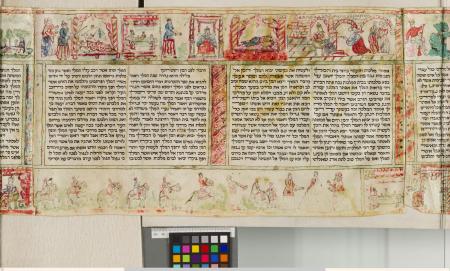Obj. ID: 35185
Hebrew Illuminated Manuscripts SUB Chinoiserie Esther Scroll, Italy, 18th century

The lavishly decorated scroll in which the Hebrew text of the Book of Esther is inscribed within double text panels. The right edge of the first membrane of the manuscript is trimmed into a decorative shape which is partly preserved. It is filled with a depiction of a garden in which musicians who are playing different instruments such as pipes, flutes, French horns, bassoons, and trumpets. Upper and lower margins adorn the scenes from the Purim story shown in the Italian realities such as architecture, costumes, and equipment. At the same time, many figures - including Mordecai - are depicted in Chinese clothing; this reflects a fascination with the Orient so popular in Europe of the 17th and 18th centuries. Besides the scenes directly related to the biblical narrative, depicted are also scenes showing Purim celebrations and likely local Purim customs and games. The decoration is supplemented with some fantastic and disproportionately large birds, flowers, and plants. Some scenes evoke associations with theatre and Purim plays. The text panels are separated by panels decorated with different patterns.
A similar megillah stored in the Library of Congress, the African and Middle Eastern Division in Washington (no. 038.00.00) is described: https://www.jewishvirtuallibrary.org/an-illuminated-megillah-judaic-treasures (accessed on 24.09.2020).
sub-set tree:
| Codex hebraicus 345
| Codex hebraicus 345
B | Buildings
C | City
B | Bird
M | Musician
M | Musical Instruments
C | Chinoiserie
O | Ornamentation: | Ornament
F | Flower
|
The scroll is formed of 7 sheets containing 28 columns of the text with 17 lines except for col. 23 with 11 lines divided into two parts.
Each membrane contains 2 text panels with 4 columns of the text.
The text is inscribed in the Hebrew square Italian script, in black ink, on the flesh side of parchment membranes that is brighter than the blank side that is more yellow.
The letter ח (Es. 1:6) is highlighted by its form (it is formed of two elements joined with a roof) and size (it is larger than an average letter in the scroll). The letter ת is enlarged and bolded (Es. 9:29). Other enlarged and diminished letters are included in col. 23.
The ruling is slightly visible, in some places only.
The membranes in the scroll are stitched.
None
Hans-Walter Stork, Falk Wiesemann, Codex hebraicus 345, [in:] Irina Wandrey ed., Manuscript Cultures, vol. 6, 249-252.
Images of the scroll are available on https://resolver.sub.uni-hamburg.de/kitodo/PPN895256576 (accessed on 24.09.2020).










